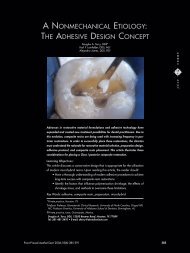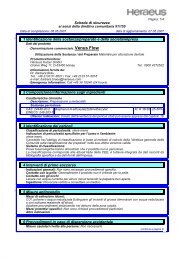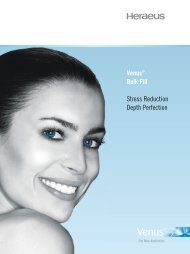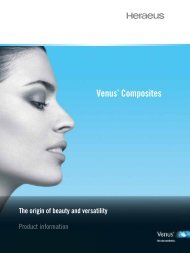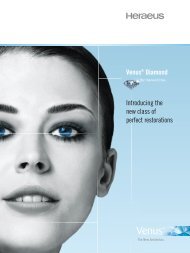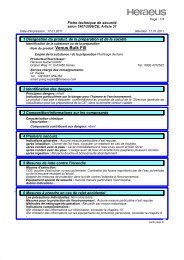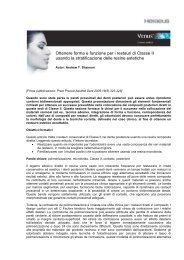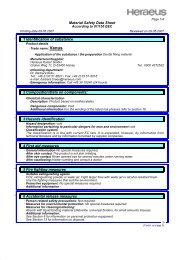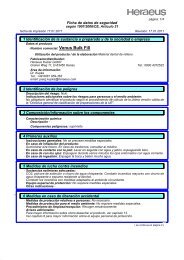Venus® Step by Step Guide Chapter 1 Layering-technique - Heraeus
Venus® Step by Step Guide Chapter 1 Layering-technique - Heraeus
Venus® Step by Step Guide Chapter 1 Layering-technique - Heraeus
You also want an ePaper? Increase the reach of your titles
YUMPU automatically turns print PDFs into web optimized ePapers that Google loves.
Introduction<strong>Heraeus</strong> Kulzer invests in research and development of dentalproducts since many years. Venus ® is the result of all experiencegained in the development of light-curing composites.Excellent aesthetics are not simply a matter of chance or timeconsumingtrial and error with Venus ® . The excellent handlingproperties, Color Adaptive Matrix, and 2Layer shade systemof Venus produce excellent aesthetics easily, quickly and reliably.All products from <strong>Heraeus</strong> Kulzer are developed in cooperationwith universities worldwide. Only this continuous scientificdiscussion allows the perception of the necessities of dentists andpatients and the study of the right solutions to these growingdemands.2
Out of this originates the formative proposal from <strong>Heraeus</strong> Kulzerand the University of Brescia in Italy. Professor Antonio Cerutti,responsible for the Department of Conservative Dentistry, andhis staff consented to build an informative document that allowsyou to go step <strong>by</strong> step into the details of the restorative dentistry.Aesthetics are nowadays a primary request from patients in alldental specialities. To combine a result that is aestheticallysuitable to the patient with the necessary functionality andlon gevity of a restoration, requires a deep knowledge of variousambits: adhesion, stratification, colour, polymerisation, finishingand polishing.The Venus ® <strong>Step</strong> <strong>by</strong> <strong>Step</strong> <strong>Guide</strong> supplies in a simple, quickand intuitive way all those concepts that will lead to appreciableimprovements in the clinical day-to-day work.Thank you for your attention and loyalty,<strong>Heraeus</strong> Kulzer3
Aesthetic composite restorations:Anterior teethFor anterior restorations it is suggested, when possible, to takean impression and make a study model of the mouth situation.A diagnostic wax-up, which enables the control before and afterthe treatment and the discussion of the therapy with the patient,should be prepared on this model. A silicone guide mask canbe prepared on the wax-up, which will be helpful for rebuildingthe palatal or lingual surfaces (Case A) and incisal edges.After placing the rubber dam, it should be checked if the prep a-ration of the incisal edges complies with the adhesion dictates.Subsequently, the chosen adhesive system can be appliedaccording to manufacturer’s instructions. A later chapter of theVenus <strong>Step</strong> <strong>by</strong> <strong>Step</strong> <strong>Guide</strong> will directly deal with the details ofthe adhesion process.The restoration should be then completed with a sequence ofenamel and incisal masses. During these last shaping thetransition lines and a portion of the surface texture should bedefined.Each single layer of composite has to be cured <strong>by</strong> using apoly merisation lamp (e.g. Translux Power Blue). In the chapterconcerning polymerisation further details of the available lampsand operational protocols will be described.Finally, after having removed the rubber dam, the occlusion test,finishing and polishing follow.The silicone guide mask should be positioned in the mouth andits borders followed so as to stratify a thin, translucent layer(shades T1, T2 or T3), which reproduces the palatal/lingual surface.Being an extremely translucent mass, the thick ness of the layerhas to be carefully controlled to avoid taking space away fromthe dentine mass.If the situation does not allow the approach with a silicone mask(Case B), the first layer has to be applied starting from the bottomof the cavity. When the use of a dentine mass is needed, theshaping should be conducted according to the precise anatomicstructure highlighted from the adjacent teeth.5
Case studies – anterior teethCase A1This young girl has two discolored restorations onthe central upper incisors. Our aim is to restore theteeth using an anatomical stratification withcomposite.Colour deterioration inold fillings on the centralupper incisors.The shade is selected.A silicone guide maskis fabricated based onthe diagnostic wax-upto ensure the bestocclusal alignment.The teeth are thenisolated with a rubberdam.6
Case studies – anterior teeth | Case A2 3The old restorations areremoved.The margins are preparedwith a diamondball bur to produce amicrochamfer.The adhesive systemis applied accordingto the manufacturer’sinstructions.The silicone guidemask is put in positionand checked foraccurate fit in relationto the adjacent teeth.A clear matrix isplaced between theteeth to optimise thereconstruction of theinter proximal zones.7
Case studies – anterior teeth | Case A4 5The palatal layer ismodelled directlyagainst the siliconeguide mask using atranslucent composite(e.g. T1) to mimic thepalatal enamel.The compositeis polymerised for20 seconds.Opaque dentine (e.g.OA2) is applied on topof the palatal increment.This incrementwill mimic the typicalincisal edge of theupper incisors. If thedefect is large, moreincrements will beneeded.Each incrementis polymerised for40 seconds.8
Case studies – anterior teeth | Case A6 7The interproximal wallis reconstructed intranslucent composite(in one or more increments)using the clearmatrix to help recreatethe characteristics ofthe natural tooth.Incisals are individua l-ised and, if necessary,effect colours are usedto recreate the amberor bluish zone.Each incrementis polymerised for20 seconds.9
Case studies – anterior teeth | Case A8 9Desaturation begins<strong>by</strong> applying layers ofenamel starting withthe deeper colours(e.g. A3) in the middlethird and progressingto lighter colours (e.g.A1) in the incisal third.It is very importantto sculpt the correctshape during thisstage.Each increment ispolymerised.The last layer oftranslucent material(e.g. T1) is applied tosimulate the vestibularenamel.The incrementis polymerised for20 seconds.Once the restoration oftooth 1.1 is completed,tooth 2.1 is restoredusing the samemethods.10
Case studies – anterior teeth | Case A10The superficial microgeographyis recreatedusing diamond burs.The restorations arepolished with diamondburs of decreasing sizeand silicone polisherson low speed micromotors.After removing therubber dam, the functionaland aestheticproperties of the rest o-rations are checked.11
Case studies – anterior teethCase B1Restorations of class III cavities in the lowerincisors are a challenge, as a number of incrementsof composite have to be applied in asmall space.Class III caries lesionin 3.1 and seriousdiscolouring of a previousrestoration in 4.1.The shade is selected.The operative field isisolated with a rubberdam.12
Case studies – anterior teeth | Case B2 3The old discolouredrestorations arecom pletely removedusing rotary and handinstruments to exposethe healthy dentaltissue, and themarginal finishing lines(microchamfer) areestablished.The cavities arerinsed.The tissues arecon ditioned withan adhesive systemac cording to themanufacturer’sinstructions.The first increment ofcomposite material isopaque (e.g. OA2) tomimic the base dentinecolour. This incrementmust be the samesize and shape as theoriginal dentine tissue.If the defect is verywide, the compositemay have to be appliedin several increments.Each individualincrement should bepolymerised for40 seconds.13
Case studies – anterior teeth | Case B4 5The characteristic incisaledges are formedand fissures appliedto the enamel. If effectcolours are to be used,they are applied now.Each increment ispolymerised.Colour desaturationis the next step withenamel shades,starting from darkershades (e.g. A3) andprogressing to lightershade composites(e.g. A1).Each increment ispolymerised.The last incrementconsists of a translucentcomposite(e.g. T1) to join themiddle third to theinterproximal zones;it should be rememberedthat the incisaledge of lower incisorsis typically translucent.The incrementis polymerised for20 seconds.14
Case studies – anterior teeth | Case B6The restoration isfinished and polished.Once the rubber damhas been removed,occlusal marking paperis used to check thatthe correct relationshipbetween reconstructionand function has beenachieved.15
Case studies – anterior teethCase C1The two central incisors appear discoloured;they had previously been restored with compositeafter trauma. Our aim is to restore the aestheticsof both teeth using direct restorations in composite.Discoloration of the twoupper central incisorswith previous trauma andcomposite restorations.The shade is selected.The operative field isisolated with a rubberdam.16
Case studies – anterior teeth | Case C23Both teeth hadreceived endodontictreatment in two earliersessions.The old discolouredrestorations arecompletely removedwith rotary instrumentsto expose healthydental tissue and themarginal finishing(micro chamfer)is established.The cavities are rinsedand the adhesivesystem applied accor d -ing to the manufacturer’sinstructions.The post is cementedinside the canal usingdual-cure cementin accordance withnormal adhesivedentistry practice.On the most badlydamaged tooth (1.1)the canal cavity is preparedfor subsequentcementing of a glassfibre post to increasethe area of adhesion.17
Case studies – anterior teeth | Case C4 5The first incrementof opaque composite(e.g. OA2) is applied,to mimic the dentinebasal colour. If thedefect is very extensive,the compositeshould be applied inseveral increments.Superficial character i-zations or fissures areapplied to the incisaledge using effectcolours, if appropriate.The restoration ispolymerised.Each incrementis polymerised for40 seconds.18
Case studies – anterior teeth | Case C6Colour desaturationis the next step withenamel shades, startingwith darker shades(e.g. A3) and progressingto lighter shadecomposites (e.g. A1).Each increment ispolymerised.The last incrementconsists of translucentcomposite (e.g. T1)to join the middle thirdto the interproximalzones.The incrementis polymerised for20 seconds.The interproximalzones are finished usinghand instruments.The palatal surface oftooth 2.1 is restoredfollowing the samesteps used to reconstruct1.1.19
Case studies – anterior teeth | Case C7The restoration isfinished and polished.Once the rubber damhas been removed,occlusal marking paperis used to check thatthe correct relationshipbetween reconstructionand function has beenachieved.20
Aesthetic composite restorations:Posterior tooth regionIn the case of a restoration in posterior teeth, the first thing todo is to decide whether the situation requires a direct or indirectsol ution. A simple rule says that a direct restoration should beplaced, when the loss of inter-cusped tissue is less than one thirdof the tooth. When the lost of tissue lays between one third andone half, there is the possibility to choose between direct andindirect restorations. And when the loss is greater than one halfan indirect restoration is needed.Modern adhesive <strong>technique</strong>s and composites enable an applicationbeyond this rule (e.g. cusp build-up) as already observed inseveral clinical cases.In preparing a direct restoration rubber dam should be placed,the compromised tissue removed and the cavity prepared asmentioned. Once the adhesive system is applied, the real restorationcan be started.The missing mesial or distal surfaces should be restored first in aclass II restoration (Case E). The stratification should begin fromthe margin for a better control of the contact area. A pre-adaptedmetallic matrix and a balsa wedge should be placed to guaranteethe best continuity with the walls of the remaining tooth structureand to create a proper contact area with the adjacent tooth. A thinwall is applied with incisal shades until the height of the occlusivearea. The approximal surface and the contact area are controlledwith a dental floss after removing the matrix (leaving the wedge toavoid bleedings). The operation should be carried out at this point,because the wall can be quickly destroyed and rebuilt, if thereshould be any errors.Once the new wall has been completed, the rebuilding of thecavity can be conducted as if it were an occlusal filling (Case D).First a layer of flow composite (e.g. Venus flow) is applied at thebottom of the cavity and spread using a probe. The purposeof this step is to create a uniform liner without air bubbles thatguarantees the best possible contact with the adhesive and acts asa loading damper. The layer of flow composite should be extremelythin to not compromise the restoration’s mechanical properties.Now the layering of dentine and enamel masses can be started.To offset the contraction caused <strong>by</strong> polymerisation, the compositeis placed in “angles”, in other words, <strong>by</strong> starting to place smallincrements in triangular shape; two walls will be in contact withthe polymerised composite and the natural tooth, while the thirdwill be free counteracting the unfavourable C-factor. In this waythe tensions on the tooth can be reduced as the contraction deve l-ops towards the centre of the mass.Characterizations, if needed, and incisal masses should be placedto end the restoration. To close, the occlusion is checked and therestoration finished and polished.21
Case studies – posterior teethCase D1An old amalgam vestibular/occlusal restorationthat presents leakage and secondary caries.The latest generation composite materials canreplace amalgam even in posterior sectors, impro v -ing the aesthetic properties and maintainingoptimum biomechanical characteristics.Leaking of an amalgamrestoration in 3.6.The shade is selected.The morphology andocclusion are assessedbefore isolating theoperative field. Thetooth involved is isolatedwith a rubberdam (the restorationwill not involve theinterproximal zone,so we can isolate thesingle tooth and notthe whole sextant).22
Case studies – posterior teeth | Case D2 3The amalgam filling isremoved with a multiflutedbur mounted ona turbine, ultrasonicscaling tips and handinstruments, to minimizethe amount ofhealthy dental tissuesacrificed.Caries detecting so -l ution can be used toensure that all carioustissue is removed.The first translucentincrement of composite(e.g. T1) isapplied to seal thevestibular surface ofthe cavity perimeter.The incrementis polymerised for20 seconds.The marginal finishingline (microchamfer)is established with a012 ball bur mountedon a turbine.Tissues are thenhybridized with anadhesive systemfollowing themanu facturer’sinstructions.23
Case studies – posterior teeth | Case D4 5The first translucentincrement of composite(e.g. T1) is applied toseal the vestibularsurface of the cavityperimeter.The incrementis polymerised for20 seconds.The stratificationbegins with a horizontalincrement ofopaque composite(e.g. OA2) that helpsto mimic the colourof the tooth to bereconstructed. If thecavity is very wide, itis better to apply thiscomposite in severalincrements.Each individualin crement ispolymerised for40 seconds.24
Case studies – posterior teeth | Case D6 7In order to desaturatethe colour, first adarker shade compo s-ite (e.g. A3.5) andthen lighter shades ofcomposite (e.g. A1)are applied.Increments are appliedin triangles in orderto reduce stresses onthe cavity walls due topolymerization shrinkageand to allow betteranatomical modelling.Stratification concludeswith the applicationof a thin increment oftranslucent composite(e.g. T1) along theedge of the cavity andalong the first part ofthe cuspal surface.The incrementis polymerised for20 seconds.Each increment ispolymerised.25
Case studies – posterior teeth | Case D8The restoration is thenfinished and polished.Once the rubber damhas been removed,occlusal marking paperis used to check thatthe correct relationshipbetween reconstructionand function has beenachieved.26
Case studies – posterior teethCase E1Recurrence of caries in this upper molar, whichhad previously been filled using amalgam; thetreatment plan is to remove the old restoration andreplace it with a composite filling.Recurrence of caries intooth 2.6, previouslyrestored with amalgam.The shade is selected.The morphology andocclusion are assessedbefore isolating theoperative field.The tooth involved isisolated with a rubberdam (as the interproximalwalls have to berestored, the adjacentteeth will have to beisolated as well as thetooth itself).27
Case studies – posterior teeth | Case E2 3The amalgam filling isremoved with a multiflutedbur mounted ona turbine, ultrasonicscaling tips and handinstruments, to minimizethe amount ofhealthy dental tissuesacrificed.Caries detecting so -l ution can be used toensure that all carioustissue is removed.The marginal finishingline (microchamfer)is established with a012 ball bur mountedon a turbine.A sectional or ringmatrix is put in pos i tionand fixed with a balsawedge so that it fitstightly against thecervical margin andthe contact area.The first vertical incrementof translucentcom posite (e.g. T1) isapplied to reconstructthe inter proximal wall;particular care mustbe taken to avoid anygaps in the cervicalmargin seal.Tissues are thenhybridized with anadhesive systemfollowing themanufacturer’sinstructions.28
Case studies – posterior teeth | Case E4The increment ispoly merised for 20seconds.The next increment oftranslucent compositecompletes the recon -s truction of the interproximalwall, exten d -ing it to the heightof the marginal crest.The incrementis polymerised for20 seconds.The matrix is removed(not the wedge, toavoid bleeding) anddental floss is used tocheck that there issufficient contact area.If this is not the case,the increments appliedmust be removed, thematrix must be repo s-itioned and the interproximalwall must bereconstructed.A layer of about0.5 mm of Venus flowis then applied andspread with a probeto eliminate any airbubbles.The layer ispoly merised.29
Case studies – posterior teeth | Case E56Stratification beginswith a horizontal incrementof opaque composite(e.g. OA2) thathelps to mimic thecolour of the tooth tobe reconstructed. If thecavity is very wide, itis better to apply thiscomposite in severalincrements.Each individual incrementis polymerised for40 seconds.In order to desaturatethe colour, first adarker shade composite(e.g. A3.5) andthen lighter shades ofcomposite (e.g. A1)are applied.Increments are appliedin triangles in orderto reduce stresses onthe cavity walls due topolymerization shrinkageand to allow betteranatomical modelling.Each increment ispolymerised.30
Case studies – posterior teeth | Case E78A thin increment oftranslucent composite(e.g. T1) is appliedalong the edge of thecavity and along thefirst part of the cuspalsurface.The incrementis polymerised for20 seconds.The restoration isfinished and polished.Once the rubber damhas been removed,occlusal marking paperis used to check thatthe correct relationshipbetween reconstructionand function has beenachieved.31
AnnexShade selection:Natural teeth are made of various kinds of tissue, which stronglydiffer aesthetically and optically wise. Dentine, for instance, isduller when compared to enamel. It is therefore clearly difficultto restore the original optical properties of a tooth using only onematerial when the cavity preparation involves both dentine andenamel.The shade selection is to be done before placing the rubber dam.Once isolated the dental element’s structures tend to dehydrate,what makes the tooth appear more shiny and opaque than normally.Consequently, just after removing the rubber dam, the restorationappears darker and too translucent, even if the composite masseshad been properly selected.At the end, the level of translucence should be defined. A recon -s truction will be able to achieve the highest aesthetical levelonly if dentine, enamel and translucent incisal shades are used.An appropriate incisal shade can be selected <strong>by</strong> determining thetranslucency of the incisal third of the tooth. When necessary,the level of translucency can be changed <strong>by</strong> using superficialcharacterisation (e.g. Cre-active) under the last translucent layer.A final evaluation of the combination of masses and layers canonly be done a few days after having completed the restoration;the composite materials attain their definite optical properties onlyafter the tooth has been rehydrated.The shade selection should be done under daylight keeping in mindthat not only the interested tooth but also the adjacent ones haveto be observed. The dentine shade should be selected based on themid and cervical thirds of the tooth of concern.32
Preparation:The penetration capacity of fluid resins or adhesives into theconditioned dental structures enable the optimisation of thematerial’s micromechanic linkage and thus the reconstruction’sresistance.The finishing of the margins allows extending the surface tomordant with acid agents and therefore increases the linkagebetween composite and dental structure.At the cervical level manual instruments should be used, becauseit is difficult to use the rotating instrument oriented at 45° withoutcausing dents. Deep class II cavities are the most difficult area.Here at least 1mm must be left before the amelo-cement junctionto assure the success of a direct restor ation (a marginal finishingat 90° should be avoided to decrease the risk of fracture).Internal corners and sharp angles should be rounded off. Thedirection of the enamel’s prisms which, during their centrifugalgrowth, place themselves in a radial manner as regards to thetooth’s axe, should also be considered. If the cavity wall showsprisms directed transversally with respect to their axe, they will bevery resistant to traction. If, instead, the cavity wall shows prismsdirected in a parallel direction with respect to their axe, theirresistance to traction will be low.Therefore, the marginal preparation should be done using a45° oriented chamfer or a microchamfer (finishing ball bur 012diameter) so as to transversally cut the prisms.33
Adhesion:Adhesion is a physical concept, which foresees interaction betweentwo elements, the adhesive and the adherent, through aninterface. In the case of amalgam fillings the restoration maintainsa macro-retention relation with the tooth. Restorations based onthe adhesion principle show a reversed concept: a micro-retentionto the tooth is achieved. The extension and shape of the cavity arein strict correlation with the decayed tissue to be removed. A largequantity of healthy dental tissue is therefore preserved.The adhesive systems can be classified according to the approachin treating dentinal mud (or smear layer). The first is in ten dedto fully remove the smear layer through a simultaneous acid conditioningof enamel and dentine (total-etch), while the secondtends to modify the same dentinal mud <strong>by</strong> incorporating it into thedentine’s resin impregnation process.Both so-called “three-steps” adhesives (e.g. Gluma Solid Bond)and those “two-steps” adhesives (e.g. Gluma Comfort Bond) area part of the first group and differ one another for the associationor not of primer and bonder.In the second group instead, we can distinguish the so-calledself-etching primers and the new self-etching adhesives or“all-in-one” bondings (e.g. iBond). These adhesive systems donot remove the smear layer but modify it.34
Polymerisation:Composites are made of a resin matrix with scattered fillingparti c les. Resins are monomers, which, following a proper phototreatment,reach their final mechanical properties throughpolymerisation. The photo-polymerisation process is thereforevery delicate and important in order to achieve a goodpredictability of the restoration.It is always recommended to observe the compositemanu fac turer’s instructions and polymerisation times.Polymerisation times for Venus and Venus flow are:A1, A2, A3, A3.5,B1, B2, C2, D2,T1, T2, T3, SB1,SB2, HKA2.5A4, B3, C3, C4,D3, OA2, OA3,OA3.5, OB2, OC3,OD2, SBO, HKA5,BaselinerAll shadesCuring time withhalogen or LEDcuring lightCuring time withhalogen or LEDcuring lightMaximum layerthickness20 seconds40 seconds2 mm35
Finishing and polishing:The finishing step, for removing composite excesses and model -ling the anatomic shape, is done using fine grain diamond bursmounted on a turbine.It is important to work at a low number of revolutions to avoiddamaging the composite’s resin matrix, which would turn opaque.During the same operational phase a correct replication of themacro- and micro-surface texture and tooth’s morphology shouldbe achieved.At the specific chapter we will deal in detail with different instrumentsand <strong>technique</strong>s to be used during the finishing andpoli shing process, highlight the differences between finishing ofanterior and posterior teeth, and the importance of a properpolishing for both aesthetical and microbiological integrationreasons.The polishing stage will follow, paying attention to the superficialmicro-morphology of the restoration. Pre-polishing is conductedwith coarse and thin grain points, polishing with silicone rubberpolishers to achieve a high gloss surface (e.g. iPol). All thepolishing processes should be carried out under a powerful air orwater jet to avoid overheating of the tooth.Once polishing is completed, fluid resin (bonding agent) can beapplied on the restoration, spread using a soft air jet, andcured for 20 seconds. This allows sealing possible cracks caused<strong>by</strong> polymerisation contraction and enables a full cure of thelast composite layer.36
ReferencesDavidson CL, de Gee AJ. Relaxation of polymerization contractionstresses <strong>by</strong> flow in dental composites. J Dent Res 1984;63:146 –148Ernst C-P. Komposit als Höckerersatz. DZW 6/06:10 –11Feilzer AJ, De Gee AJ, Davidson CL. Setting stress in compositeresin in relation to configuration of the restoration. J Dent Res1987;66:1636–1639Grandini R, Rengo S, Strohmenger L. Odontoiatria Restaurativa.Ed. UTET (To) 1999Roberson T, Heymann HO, Swift EJ. Sturdevant’s Art and Scienceof Operative Dentistry. Ed. Elsevier 2006Vanini L, Mangani F. Il Restauro Conservativo dei Denti Anteriori.Ed. Promodent 2003Conception:Raquel Neumann<strong>Heraeus</strong> Kulzer GmbH37
Venus ® indicationsVenus ® shadesIndication Venus Venus flowClass I cavities • •(not subject to chewing pressure)Class II cavities • •(not subject to chewing pressure)Class III cavities • •(slightly subject to strain)Class IV cavities • •Class V cavities • •Inlays(direct and indirect)Onlays(direct and indirect)Veneers(direct and indirect)•••Crown build-ups • •Posts and cores • •Adhesive lutingTemporaryrestorations• •Fissure andpit sealing•Cavity linings ••(Only veneers, light cured)Enamel shades(highertransparency)Enamel shades(very hightransparency)Dentine shades(lowtransparency)Venus shades are matched to Vita ® shades.*<strong>Heraeus</strong> Kulzer shadesA1 B1 C2 D2 SB1*A2 B2 C3 D3 SB2*A3 B3 C4A3.5A4HKA2.5*HKA5*T1T2T3OA2 OB2 OC3 OD2 SBOOA3OA3.5The Venus ® tones are tuned to the Vita ® colours.Customised shades for whitened teeth:Shade SB1: Super Bleach (warm), light incisal shadeShade SB2: Super Bleach (cold), light incisal shade with aslightly cool blue hue effectShade SBO: Super Bleach Opaque, light dentine shade,low transparency38
Venus ® product outlineVenus ® Masters KitVenus ® Basic KitVenus ® flow Assortment2Layer Shade <strong>Guide</strong>This kit was developedfor dentists, who want tomake clinical use ofthe complete range ofVenus shades and beready for all cases.This kit contains the6 most commonly usedenamel and dentineshades, as well as theincisal shade T1“cool blue”. It is idealas a starter set.Venus flow shades areperfectly matched tothe Venus shades. Youhave a choice between14 Venus flow shades.This assortment containsthe 4 most popular ones.Hand layered, madefrom original material.Venus PLTs* 10 x 0.25 gshades A1, A2, HK A2.5, A3, A3.5,B1, BVenus PLTs* 5 x 0.25 gshades A4, HK A5, B3, C2, C3, C4,D2, D3, OA2, OA3, OA3.5, OB2, OC3,OD2, SB1, SB2, SBO, T1, T2, T3Venus syringes 4 g orPLTs* 10 x 0.25 gshades A2, A3, OA2, OA3,T1, HKA2.5Venus shade guideAccessoriesVenus flow syringes 1,8 gshades A1, A2, A3,Baseliner WhiteAccessoriesshades A1, A2,HKA25, A3, A3.5, A4,HKA5, B1, B2, B3,C2, C3, C4, D2, D3,SB1, SB2, T1, T2, T3Venus flow syringe 1.8 gshades A2, BaselinerGluma Desensitizer 1mlVenus shade guideVenus shade guide with6 empty tabsVenus DVD Master’s Aesthetic SeriesAccessoriesArt. No. 66013214 Art. No. 66013214 Art. No. 66014561Art. No. 66008711*PLTs = pre-loaded capsules for direct application39
Venus ® product outlineProductArt. No.ProductArt. No.ProductArt. No.VenusPLTs contents 20 x 0.25 g■ PLT – A1 66007979■ PLT – A2 66007981■ PLT – A3 66007983■ PLT – A3.5 66007985■ PLT – B1 66007988■ PLT – B2 66008000■ PLT – C2 66007989■ PLT – OA2 66008012■ PLT – HKA2.5 66007996PLTs contents 10 x 0.25 g■ PLT – A4 66008159■ PLT – B3 66008001■ PLT – C3 66008089■ PLT – C4 66008003■ PLT – D2 66007992■ PLT – D3 66008095■ PLT – OA3 66008016■ PLT – OA3.5 66007997■ PLT – OB2 66007999■ PLT – OC3 66008002■ PLT – OD2 66008004■ PLT – SB1 66008008■ PLT – SB2 66008009■ PLT – SBO 66008014■ PLT – T1 66007995■ PLT – T2 66008005■ PLT – T3 66008006■ PLT – HKA5 6600799840VenusEach syringe contains 4 g■ SYR – A1 66007366■ SYR – A2 66007367■ SYR – A3 66007368■ SYR – A3.5 66007369■ SYR – A4 66008156■ SYR – B1 66007370■ SYR – B2 66007600■ SYR – B3 66007601■ SYR – C2 66007371■ SYR – C3 66008086■ SYR – C4 66007603■ SYR – D2 66007372■ SYR – D3 66008092■ SYR – OA2 66007410■ SYR – OA3 66008098■ SYR – OA3.5 66007597■ SYR – OB2 66007599■ SYR – OC3 66007602■ SYR – OC2 66007604■ SYR – SB1 66007608■ SYR – SB2 66007609■ SYR – SBO 66007411■ SYR – T1 66007373■ SYR – T2 66007605■ SYR – T3 66007606■ SYR – HKA2.5 66007596■ SYR – HKA5 66007598Venus flowEach syringe contains 1.8 g■ Venus flow – A1 66014562■ Venus flow – A2 66014563■ Venus flow – A3 66014565■ Venus flow – A3.5 66014566■ Venus flow – A4 66014567■ Venus flow – B2 66014568■ Venus flow – B3 66014569■ Venus flow – OA2 66014570■ Venus flow – SB1 66014571■ Venus flow – SB2 66014572■ Venus flow – SBO 66014573■ Venus flow – T2 66014575■ Venus flow Baseliner White 66014574■ Venus flow – HKA2.5 66014564
Conception:<strong>Heraeus</strong> Kulzer GmbHThanks to:Prof. Antonio CeruttiNicola BarabantiStefano SicuraUniversity Brescia, ItalyXXXXXXXX 00 02.08 GB<strong>Heraeus</strong> Kulzer srlContact in Germany<strong>Heraeus</strong> Kulzer GmbHGrüner Weg 1163450 HanauPhone +49 (0) 6181 355 444Fax +49 (0) 6181 353 461info.dent@heraeus.comwww.heraeus-kulzer.deContact in the United Kingdom<strong>Heraeus</strong> Kulzer Ltd.<strong>Heraeus</strong> House, Albert RoadNorthbrook Street, NewburyBerkshire, RG14 1DLPhone +44 (0) 1635 30500Fax +44 (0) 1635 30606Mail: sales@kulzer.ukwww.heraeus-kulzer.comContact in Australia<strong>Heraeus</strong> Kulzer Australia Pty. Ltd.Locked Bag 750Roseville NSW 2069Phone +61 29 417 8411Fax +61 29 417 5093Mail: sales@kulzer.com.auwww.kulzer.com.auIn compliance with the European guideline 93/42/EWG our medical devices are CE-marked according to the classifi cations.





